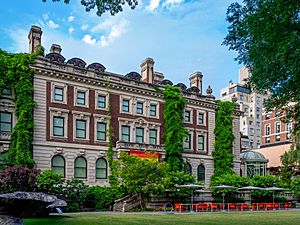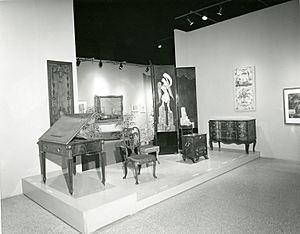Cooper Hewitt, Smithsonian Design Museum facts for kids
 |
|

The garden and entrance to the Cooper Hewitt museum.
|
|
| Established | 1897 |
|---|---|
| Location | Andrew Carnegie Mansion Manhattan, New York, United States |
| Public transit access | Bus: M1, M2, M3, M4, M86, M96, M106 Subway: |
Cooper Hewitt, Smithsonian Design Museum is a design museum located in the historic Andrew Carnegie Mansion in Manhattan, New York City. It is part of the famous Museum Mile on the Upper East Side. The Cooper Hewitt is one of 19 museums that make up the Smithsonian Institution.
It is the only museum in the United States that is all about historical and modern design. Its collections and exhibits show how design and creativity have shaped America's history. Unlike most other Smithsonian museums, Cooper Hewitt charges a fee to enter.
Contents
History of the Museum
How It All Started
In 1895, the granddaughters of a famous businessman named Peter Cooper had a great idea. Sarah, Eleanor, and Amy Hewitt wanted to create a museum inspired by one in Paris. They wanted a place where students and designers could study collections of decorative arts.
The Cooper Union college gave them space on its fourth floor. The "Cooper Union Museum for the Arts of Decoration" opened in 1897. It was free and open to the public three days a week. The Hewitt sisters even donated their own art objects to get it started.
Over the years, the museum's collection grew. It received important gifts, like textile collections from the famous banker J. P. Morgan. By the mid-20th century, the museum had furniture, wallpaper, jewelry, and thousands of drawings.
A Time of Trouble
By the 1960s, the museum was struggling. It was in a location that was hard for visitors to find. The Cooper Union college, which ran the museum, was also having money problems. In 1963, the college announced it might have to close the museum for good.
This news worried many people who loved art. They feared the amazing collection would be broken up and sold. A group called the "Committee to Save the Cooper Union Museum" was formed to protect it. They even threatened to sue the college to keep the museum open.
The Smithsonian Steps In
The famous Smithsonian Institution heard about the museum's troubles. In 1967, the Smithsonian agreed to take over the museum's collection and library. This was a huge deal because it meant the collection would be safe.
The museum moved to a new, much larger home: the Andrew Carnegie Mansion. This beautiful mansion was once the home of the wealthy industrialist Andrew Carnegie. The museum officially became part of the Smithsonian on July 1, 1968. It was the first Smithsonian museum located outside of Washington, D.C.
The museum reopened to the public on October 7, 1976. It was now the only museum in the U.S. focused entirely on design.
Growing and Changing
Under a new director, Lisa Taylor, the museum began offering classes and programs for both kids and adults. In 1982, it started a master's degree program with the Parsons School of Design.
The museum's name changed a few times to better describe its mission. In 1988, it became Cooper-Hewitt, National Design Museum. This new name showed that it focused on the process of design, not just the finished objects.
In the 1990s, the museum went through a major renovation to improve its galleries. The project cost $20 million and helped make the space better for showing off modern design.
The Museum in the 21st Century
From 2011 to 2014, the museum closed for its biggest renovation ever. The $91 million project expanded the gallery space and added new interactive features.
When it reopened in December 2014, it had a new name: Cooper Hewitt, Smithsonian Design Museum. It also introduced cool new technology. One new feature was the "Immersion Room," where visitors can see the museum's huge wallpaper collection digitally. Visitors also get a special digital "Pen" to "collect" their favorite objects from the exhibits and learn more about them online later.
In 2022, Maria Nicanor was appointed as the museum's new director.
The Museum's Amazing Collection

The Cooper Hewitt has more than 200,000 design objects in its collection. These items range from everyday things like matchbooks and shopping bags to rare and valuable art.
Art and Drawings
The museum has the world's largest collection of works by the famous painter Frederic Edwin Church. It also has many drawings by other well-known artists like Winslow Homer. In 2002, a rare 16th-century drawing by the great artist Michelangelo was discovered in the collection. The museum had bought it for only $60 back in 1962!
Furniture and Other Objects
The furniture collection includes many interesting pieces. There is a chair that Abraham Lincoln sat in, a cardboard chair designed by architect Frank Gehry, and the first steel chair ever made in the United States.
The collection also includes thousands of other items, such as:
- A large collection of lace
- Buttons and match cases
- Locks and keys
- Drawings of skyscrapers
- A Rolls-Royce car that once belonged to John Lennon of The Beatles.
What You Can See at the Museum
Cooper Hewitt's exhibitions explore the history and culture of design. The shows often focus on a single topic, from architecture to fashion.
Past Exhibitions
Over the years, the museum has hosted exhibits on many fascinating subjects. Some popular past shows have included:
- The history of ocean liners
- The jewelry of Van Cleef & Arpels
- The art of Sonia Delaunay
- The history and power of maps
- The design of everyday objects, like bike racks and teapots
In 2015, the museum held the world's first auction of computer algorithms, showing how even computer code can be a form of design.
Traveling Exhibitions
The museum also creates exhibits that travel to other cities through the Smithsonian Institution Traveling Exhibition Service. This allows people all over the country to see parts of the Cooper Hewitt's collection. One of its most popular traveling shows was "The Power of Maps," which was shown on the National Mall in Washington, D.C.
Programs and Learning
The Cooper Hewitt offers many programs for people of all ages. It has workshops for kids, summer camps, and resources for teachers. In 2012, the museum opened a special education center in the Harlem neighborhood to provide free design programs to the community.
Every year, the museum hosts the National Design Awards, which celebrate the best designers in America. It also sponsors National Design Week in New York City, a week of events and free admission to the museum.
The Museum Building
The Cooper Hewitt is located in the Andrew Carnegie Mansion, a grand 64-room house built in 1902. Andrew Carnegie, one of the richest men in America at the time, lived there with his family. The building has a large, beautiful private garden that is open to the public.
The museum moved into the mansion in the 1970s. The building has been renovated several times to create more space for exhibits and to add modern technology. After the 2014 renovation, the museum even released a 3D scan of the mansion that you can download and explore on your computer.
See also
 In Spanish: Museo Nacional de Diseño Cooper-Hewitt para niños
In Spanish: Museo Nacional de Diseño Cooper-Hewitt para niños
- List of museums in New York City
- List of museums and cultural institutions in New York City
- List of design museums
Images for kids




